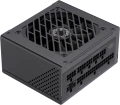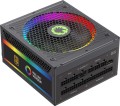Form factor
The form factor determines, first of all, the dimensions, and, as a result, the purpose of the power supply. To date, there are such main form factors:
—
ATX. Conventionally, it can be called "standard" — this is the most common form factor for regular-sized desktop PCs (in Full Tower and Midi Tower cases).
—
TFX. Compact form factor, designed specifically for small cases (in particular, Mini Tower). Due to their intended use, these power supplies are typically lower than full-sized ATX power supplies, while electrically they are fully ATX compliant.
—
SFX. Modification of the ATX form factor, developed at the end of the 20th century as a power supply option for systems in miniature microATX and FlexATX form factors (the S in the name stands for "small", i.e. "small"). Accordingly, the main difference is the dimensions: they are much smaller and amount to (width-depth-height) 100x125x64 mm with a standard 60 mm fan. When installing larger or smaller fans, the height of the unit changes accordingly; there are other deviations from the standard (for example, a slightly greater depth). The power connectors are almost identical to the original ATX, and these two standards are considered completely interchangeable.
Cooling system
—
Active cooling system. Uses a fan that constantly operates to remove heat from internal components. Unlike passive cooling, the active system provides better heat dissipation and stability under high loads, preventing overheating. However, it creates noise. To eliminate this, fans in such power supplies can have dynamic speed control (AFC – Automatic Fan Control), reducing speed at low power consumption.
—
Semi-passive. Active cooling systems with automatic fan shutdown in situations where the load on the power supply is low and heat generation is reduced. Let us remind you that systems of this type are more efficient than passive ones, but they consume additional energy and create noise during operation. Accordingly, at low loads, when intensive cooling is not required, it is wiser to turn off the fans — this saves energy and reduces the noise level.
—
Passive(radiators). Compared to fans, radiators have a number of advantages: for example, they do not create any noise and do not require their own power supply (thus reducing overall energy consumption). On the other hand, they are significantly less efficient, as a result — the power of power supplies with passive cooling does not exceed 600 W. In addition, such power supplies are quite expensive.
Fan size
The diameter of the fan(s) in the power supply cooling system.
The large diameter allows to achieve good efficiency at relatively low RPMs, which in turn reduces noise and power consumption. On the other hand, large fans are more expensive than small ones and take up a lot of space, which affects the dimensions of the entire PSU. We also emphasize that a small fan is not yet a sign of a cheap power supply — quite advanced models can also have such equipment, in order to reduce dimensions.
As for specific diameters, the smallest value that can be found in modern consumer-grade PSUs is
80 mm. The most popular option is
120 mm, this size gives good efficiency and a relatively low noise level at a reasonable price and dimensions. Larger diameters are somewhat less common —
135 mm and
140 mm.
SATA
The number of SATA power connectors provided in the PSU.
Nowadays, SATA is the standard interface for connecting internal hard drives, and it is also found in other types of drives (SSD, SSHD, etc.). Such an interface consists of a data connector connected to the motherboard, and a power connector connected to the PSU. Accordingly, in this paragraph we are talking about the number of SATA power plugs provided in the PSU. This number corresponds to the number of SATA drives that can be simultaneously powered from this model.
PCI-E 8pin (6+2)
The number of PCI-E 8pin (6+2) power connectors provided in the PSU design.
Additional PCI-E power connectors (all formats) are used to additionally power those types of internal peripherals for which 75 W is no longer enough, supplied directly through the PCI-E socket on the motherboard (video cards are a typical example). In PC components, there are two types of such connectors — 6pin, providing up to 75 W of additional power, and 8pin, giving up to 150 W. And the 8pin (6 + 2) plugs used in power supplies are universal: they can work with both 6-pin and 8-pin connectors on the expansion board. Therefore, this type of plug is the most popular in modern PSUs.
As for the quantity, on the market you can find models
for 1 PCI-E 8pin (6 + 2) connector,
for 2 such connectors,
for 4 connectors, and in some cases —
for 6 or more. Several of these plugs can be useful, for example, when connecting several video cards — or for a powerful high-performance video adapter equipped with several PCI-E additional power connectors.
Floppy
The presence of at least one Floppy power connector in the PSU.
Initially, this connector was intended to power floppy disk drives, hence the name. It is also known under the designation "mini-Molex". Anyway, this standard is generally considered obsolete, but it is still used by some specific types of components, and therefore continues to be used in power supplies.
Braided wires
The presence of a braid in the complete wires of the system unit — for all or at least for some.
This feature has a positive effect on reliability, making the wire as resistant as possible to bending, abrasion, strong pressure and other similar influences; it also provides additional protection against accidental contact with sharp objects (for example, when repairing a PC). The disadvantages of braided wires, in addition to increased cost, are also increased thickness and greater rigidity than similar cables in conventional insulation. This can create some difficulties in organizing space inside the system unit.
+3.3V
The maximum values of current and power that the PSU can provide on individual power lines.
The power line can be simply described as a pair of contacts for connecting a particular load; one of these contacts is “ground” (with zero voltage), and the second has a certain voltage with a plus or minus sign, this voltage corresponds to the voltage of the power line. In this paragraph, it is + 3.3V (such power is present in 20- and 24-pin connectors for motherboards, in SATA power connectors and some other types of connectors).
In general, power and currents are rather specific parameters that the average user rarely needs — mainly when connecting high-power components such as video cards, as well as when starting a PSU without a computer to power other electronics (for example, amateur radio stations). It is also worth mentioning that the sum of the maximum powers on all lines can be higher than the total output power of the PSU — this means that all lines cannot operate at full power at the same time. Accordingly, when the PSU is fully loaded, some of them will produce less power than the maximum possible.
+5V
The maximum current that the PSU is capable of issuing + 5V to the power line. For more information about power lines in general, see "+3.3V". Also note here that + 5V power, in addition to connectors for motherboards (for 20 and 24 pins), is also found in Molex and SATA plugs, as well as some other specific types of connectors.

